AUDI R8 SPYDER 2011 Owners Manual
Manufacturer: AUDI, Model Year: 2011, Model line: R8 SPYDER, Model: AUDI R8 SPYDER 2011Pages: 244, PDF Size: 59.74 MB
Page 111 of 244
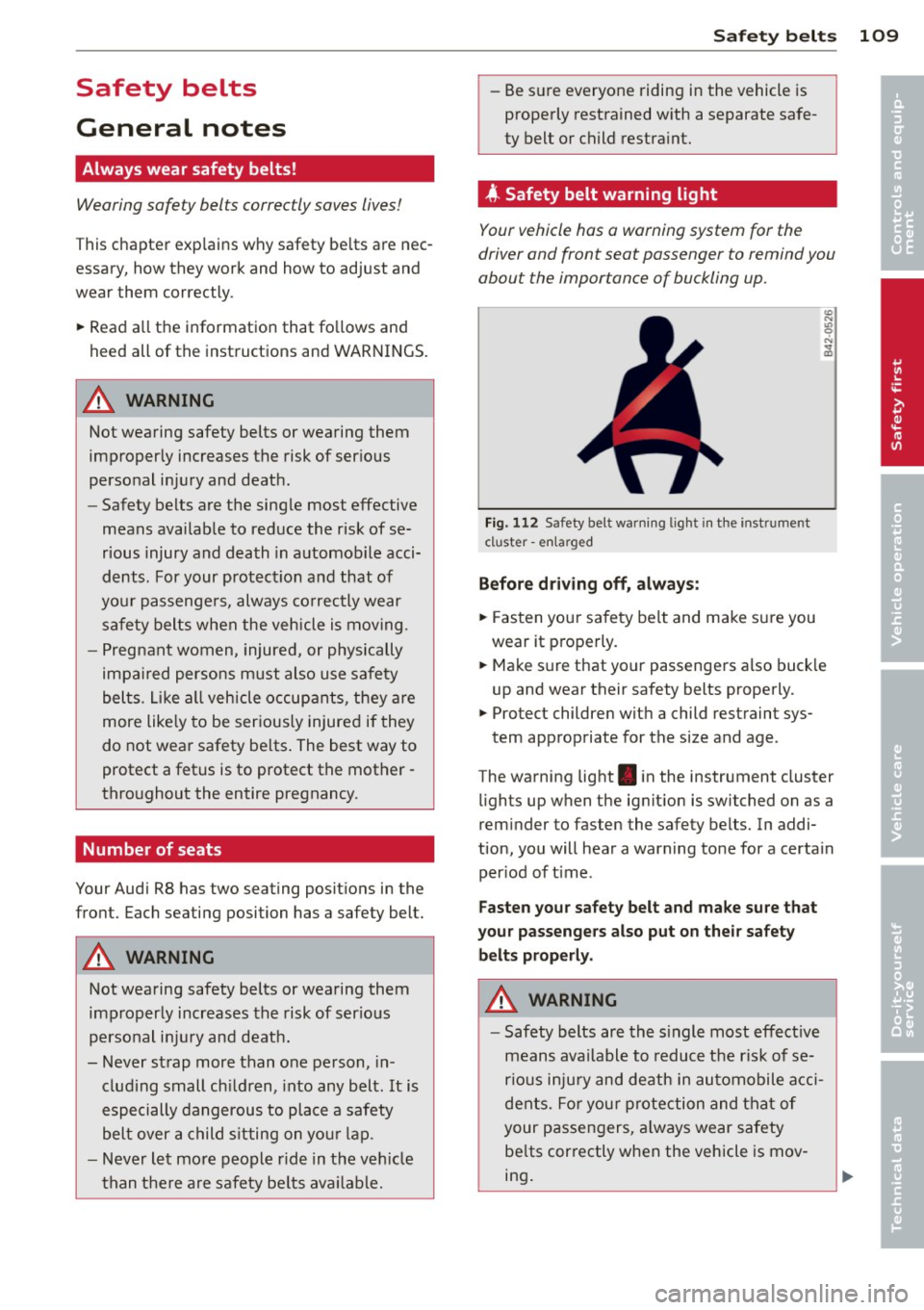
Safety belts
General notes
Always wear safety belts!
Wearing safety belts correctly saves lives!
This chapte r exp lains why safety be lts a re nec
essary, how they work and how to adjust and
wear them correctly.
~ Read a ll the informat ion that fo llows and
heed all of the inst ruct ions and WARNINGS.
A WARNING
Not wearing safety belts or wearing them
imp roperly increases the risk of ser ious
personal in jury and death .
- Safety belts are the sing le most effective
means availab le to red uce the r isk of se
rious injury and death in a utomob ile acci
dents . For your prot ecti on and that of
yo ur passenge rs, always co rrec tly wear
sa fe ty bel ts when the ve hicle is mov ing.
- P re g nant women, injured, or physically
impa ired perso ns must also use safe ty
belts. L ike a ll vehicle occup ants, they are
more like ly to be ser ious ly injure d if they
do not wea r safety be lts . The best way to
protect a fet us is to protect the mother -
thro ughout the entire pregnancy.
Number of seats
Your Audi R8 has two seating posit ions in the
front. Each seating position has a safety belt.
A WARNING
Not wearing safety belts or wearing them
im proper ly increases the risk of ser ious
pe rsonal in ju ry and death.
- Never st rap more than one person, in
clu ding small ch ild ren, into any belt. It is
especially dangerous to place a safety
belt over a child s itting on yo ur lap.
- Never let mo re people ride in the ve hicle
t h an t he re are safety be lts ava ilable.
Sa fety belts 109
- Be s ure everyone riding in the vehicle is
properly restrained w ith a separate sa fe
ty belt or child restra int.
4 Safety belt warning light
Your vehicle has a warning system for the
driver and front seat passenger to remind you
about the importance of buckling up .
Fig. 1 12 Safety be lt warn ing lig ht in the instr ume nt
cl uster -enla rged
Befor e driv ing off, always :
~ Fasten your sa fe ty belt and make su re you
wear it p roperly.
~ Make s ure that yo ur passenge rs a lso buck le
up and wear their safety belts properly.
~ Protect children with a child rest raint sys-
tem appropriate for the size and age .
The wa rning light . in the instrument cluster
li ghts up w hen t he ig nit ion is switched on as a
rem inder to fasten the safety belts. In addi
tion , you will hear a warning tone for a certa in
per iod of t ime .
Fasten your safety belt and make sure that
your passengers also put on the ir safety
belts proper ly.
A WARNING
- Safety belts are the s ingle most effect ive
means ava ilable to reduce t he risk of se
rio us i nju ry and death in au tomobile a cci
dents. Fo r yo ur protection and tha t of
your passengers, a lways wear safety
be lts cor rectly when the vehicle is mov
ing . •
•
Page 112 of 244
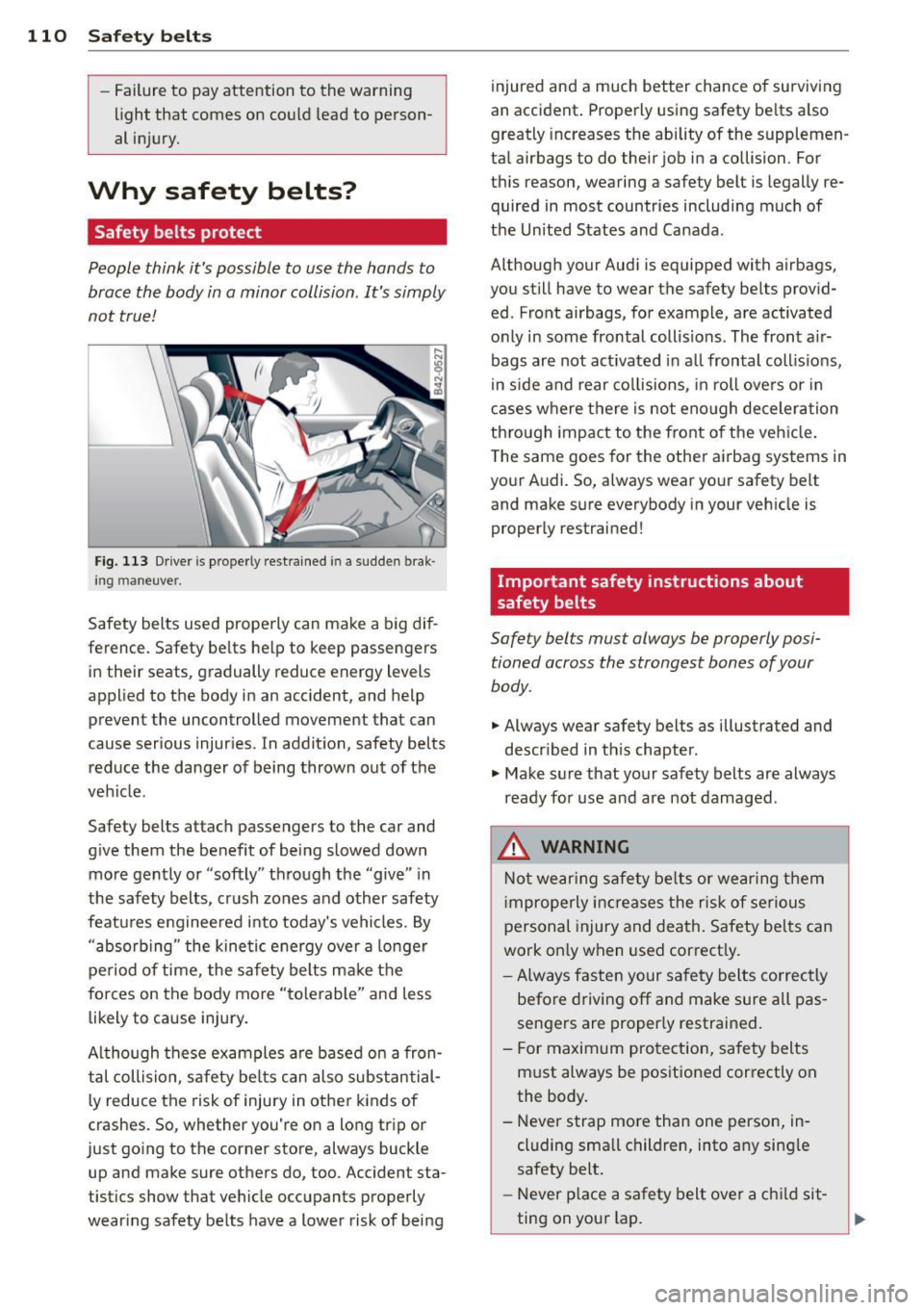
110 Safety belts
-Failure to pay attention to the warning
light that comes on could lead to person
al injury.
Why safety belts?
Safety belts protect
People think it's possible to use the hands to
brace the body in a minor collision. It's simply
not true!
Fig. 113 D river is proper ly restrai ned in a sudden brak
ing maneuver .
Safety belts used properly can make a big dif
ference. Safety belts help to keep passengers
in their seats, gradually reduce energy levels
applied to the body in an accident, and help prevent the uncontrolled movement that can
cause serious injuries. In addit ion, safety belts
reduce the danger of being thrown out of the
vehicle.
Safety belts attach passengers to the car and
give them the benefit of being slowed down
more gently or "softly" through the "give" in
the safety belts, crush zones and other safety
features engineered into today's vehicles. By
"absorb ing" the kine tic energy over a longer
period of time, the safety belts make the
forces on the body more "tolerable" and less
likely to cause injury.
A lthough these examples are based on a fron
tal collision, safety belts can also substantial
ly reduce the risk of injury in other kinds of
crashes. So, whether you're on a long trip or
just going to the corner store, always buckle up and make sure others do, too. Accident sta
tistics show that vehicle occupants properly
wear ing safety be lts have a lower risk of being injured and a much better chance of surviving
an accident . Prope rly using safety be lts a lso
greatly increases the ability of the supplemen
ta l airbags to do their job in a collision. For
th is reason, wearing a safety belt is legally re
quired in most countries including much of
the Un ited States and Canada.
Although your Audi is equipped with a irbags,
you still have to wear the safety belts provid ed. Front airbags, for example, are activated
only in some frontal collisions . The front air
bags are not act ivated in all frontal coll is ions,
in sid e and rear collisions , in roll overs or in
cases where there is not enough deceleration
through impact to the front of the vehicle.
T he same goes for the other airbag systems in
your Audi. So, always wear yo ur safety belt
and make sure everybody in your veh icle is
proper ly restrained!
Important safety instructions about
safety belts
Safety belts must always be properly posi
tioned across the strongest bones of your
body .
.,. Always wear safety belts as illustrated and
descr ibed in th is chapter .
.,. Make sure that your safety belts are always
ready for use and are not damaged .
_&. WARNING
Not wearing safety belts or wearing them
imprope rly increases the risk of serious
personal injury and death. Safety belts can
work only when used correctly.
- Always fasten your safety belts correctly
before driving off and make sure all pas
sengers are properly restrained.
- For maximum protection, safety belts
must always be positioned correctly on
the body.
- Never strap more than one person, in
cluding sma ll children, into a ny sing le
safety belt.
- Never place a safety belt over a child sit
ting on your lap.
Page 113 of 244
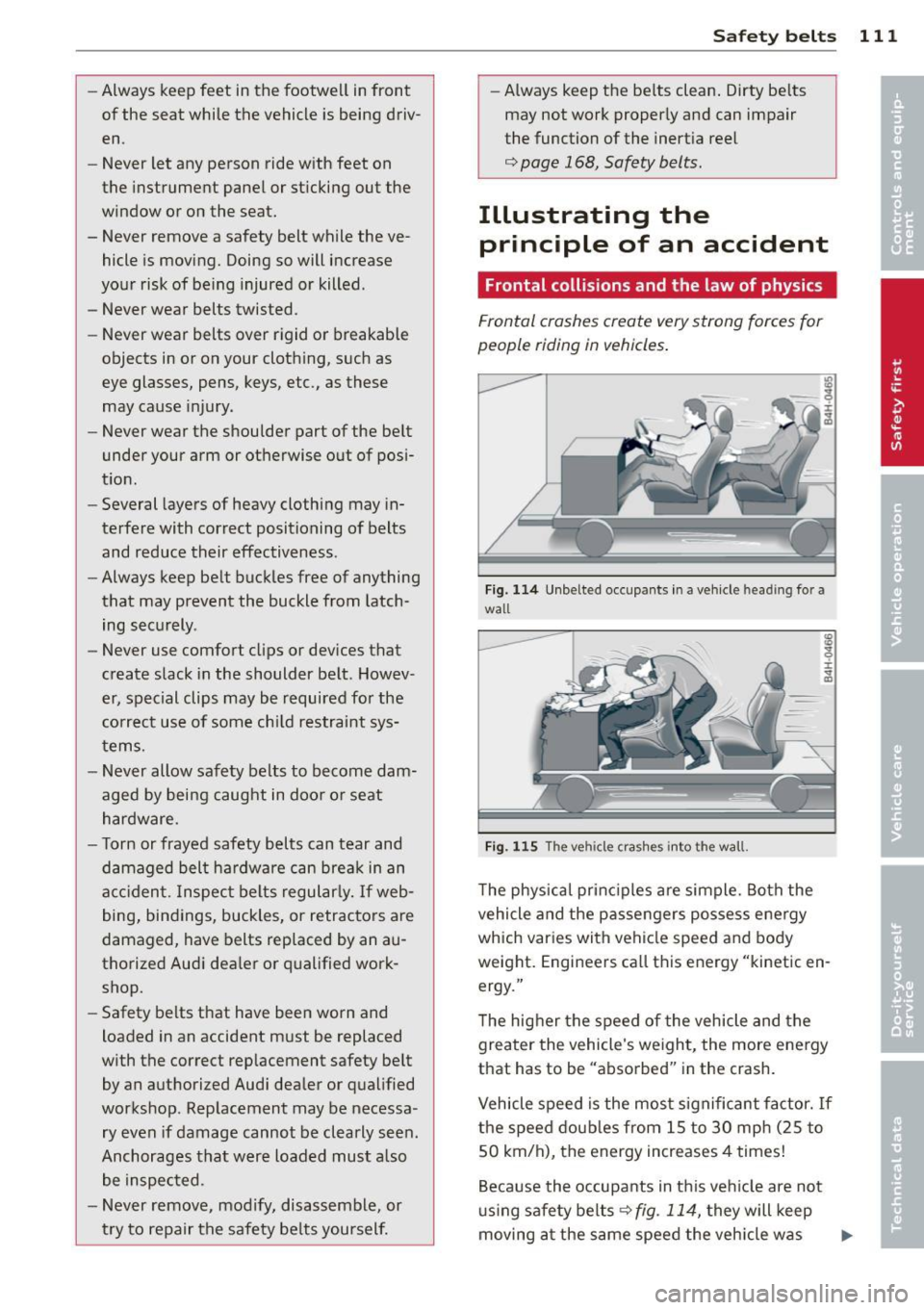
-Always keep feet in the footwell in front
of the seat while the vehicle is being driv
en .
- Never let any person ride with feet on
the instrument panel or sticking out the
window or on the seat.
- Never remove a safety belt while the ve hicle is moving. Doing so will increase
your risk of being injured or killed .
- Never wear belts twisted.
- Never wear belts over rigid or breakable
objects in or on your clothing, such as
eye glasses, pens, keys, etc., as these
may cause injury.
- Never wear the shoulder part of the belt
under your arm or otherwise out of posi
t ion .
- Several layers of heavy clothing may in
terfere with correct positioning of belts
and reduce their effectiveness .
- Always keep belt buckles free of anything
that may prevent the buckle from latch
ing securely .
- Never use comfort clips or devices that
create slack in the shoulder belt. Howev
er, special clips may be required for the
correct use of some chi ld restraint sys
tems.
- Never allow safety belts to become dam
aged by being caught in door or seat
hardware.
- Torn or frayed safety belts can tear and
damaged belt hardware can break in an
accident. Inspect belts regularly.
If web
bing, bindings, buckles, or retractors are
damaged, have belts replaced by an au
thorized Audi dea ler or qualified work
shop.
- Safety belts that have been worn and
loaded in an accident must be replaced
with the correct replacement safety belt
by an authorized Audi dealer or qualified
workshop . Replacement may be necessa
ry even if damage cannot be clearly seen.
Anchorages that were loaded must also
be inspected .
- Never remove, modify, disassemble, or
try to repair the safety belts yourself.
Safety belts 111
-Always keep the belts clean. Dirty belts
may not work properly and can impair
the function of the inertia reel
c:> page 168, Safety belts .
Illustrating the
principle of an accident
Frontal collisions and the law of physics
Frontal crashes create very strong forces for
p eople riding in vehicles .
Fig. 114 Unbelted occupants in a vehicle heading for a
wa ll
Fig. 11S The ve hicle c rashes in to the wal l.
The physical principles are simple. Both the
vehicle and the passengers possess energy
which vari es with vehicle speed and body
weight. Eng ineers call this energy "k inetic en
ergy."
The higher the speed of the vehicle and the
greater the vehicle's weight, the more energy
that has to be "absorbed" in the crash.
Vehicle speed is the most significant factor.
If
the speed doubles from 15 to 30 mph (25 to
50 km/h), the energy increases 4 times!
Because the occupants in this vehicle are not
using safety belts
c:>fig . 114, they will keep
moving at the same speed the veh icle was .,,_
Page 114 of 244
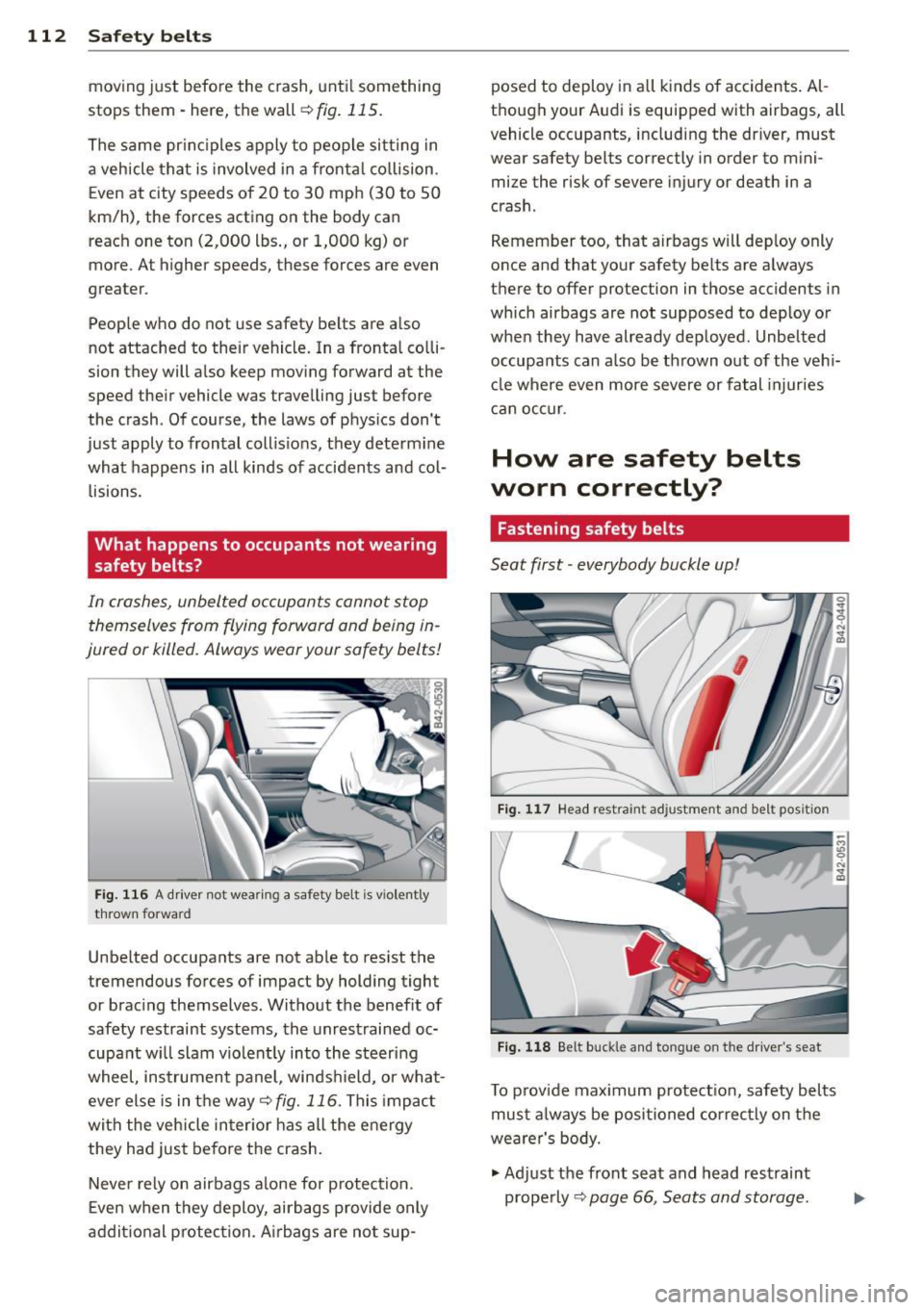
112 Safet y belt s
movin g ju st before the crash, unti l something
stops them· here, the wall
r::!;> fig. 115.
The same pr inc iples apply to people sitting in
a veh icle that is involved in a fronta l co llision .
Even at city speeds of 20 to 30 mph (30 to 50
km/h), the forces acting on the body can
reach one ton (2,000 lbs., or 1,000 kg) or
more. At higher speeds, these forces are even
greater .
Peop le who do not use safety be lts are a lso
not attached to their vehicle. In a fronta l colli
sion they will also keep mov ing forward at the
speed their vehicle was trave lling just before
the crash . Of course, the laws of physics don't
just apply to frontal coll is ions, they determ ine
what happens in all kinds of accidents and col·
lisions.
What happens to occupants not wearing
safety belts?
In crashes, unbelted occupants cannot stop themselves from flying forward and being in
jured or killed. Always wear your safety belts!
Fi g. 11 6 A driver not wear ing a safety belt is violently
t h rown forward
Unbe lted occupants are not able to res ist the
tremendous fo rces of impact by holding tight
or brac ing themselves. Without the benef it of
safety restraint systems, the unrestrained oc·
cupant w ill slam vio lent ly into the steering
wheel, instrument panel, windshield, or what eve r else is in the way¢
fig. 116. This impac t
with the veh icle inter ior has all the energy
they had just before the crash.
Neve r rely on airbags a lone for p rotection.
E ven when they deploy, airbags provide only
addit ional p rotec tion. A irbags are no t sup- posed to deploy in all k
inds of accidents . Al
though your Audi is equipped with airbags, all
vehicle occupants, includ ing the driver, must
wear safety belts correctly in order to mini
mize the risk of severe injury or death in a
crash .
Remember too, that airbags will deploy only
once and that your safety belts are always
there to offer protection in those accidents in
which airbags are not supposed to dep loy or
when they have already dep loyed. Unbelted
occupants can a lso be th rown out of the veh i
cl e where even more severe or fatal injuries
ca n occ ur.
How are safety belts
worn correctly?
Fastening safety belts
Seat first · everybody buckle up!
Fig . 11 7 Head restraint adjustment and belt position
Fig. 11 8 Belt buck le an d tongue on the dri ver's seat
To p rov ide max imum protect ion, safety belts
must a lways be posi tioned co rrec tly on the
wea rer's body.
.. Adjust the front seat and head rest raint
p rope rly
r::!;> page 66, Seats and storage.
Page 115 of 244
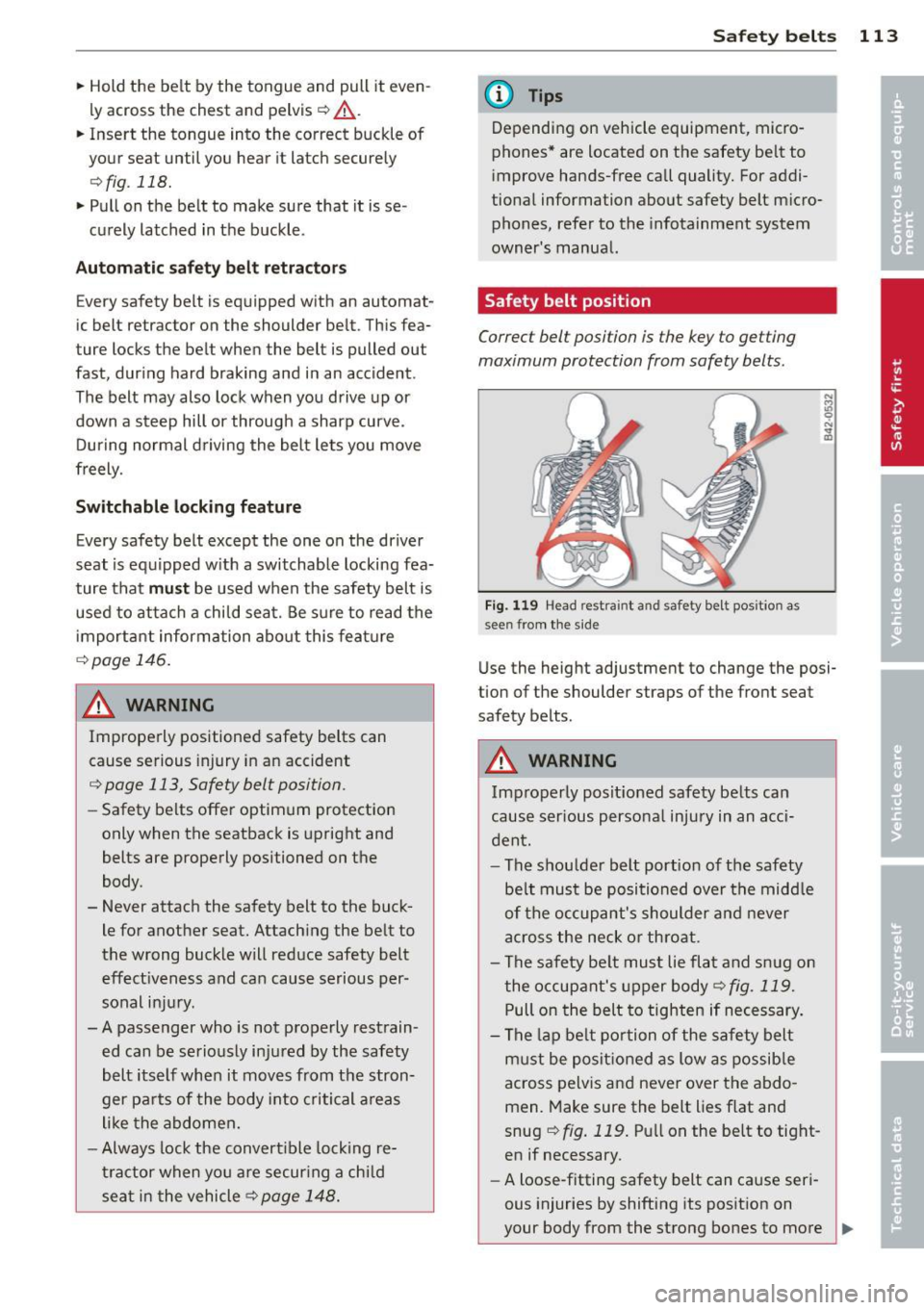
.. Hold the be lt by the tongue and pull it even
l y across the chest and pelvis
c::> &_.
.. Insert the tongue into the correct buckle of
your seat until you hear it latch securely
c::>fig. 118.
.. Pull on the belt to make sure that it is se-
c u rely latched in the buckle.
Automatic safety belt retracto rs
Every safety belt is equipped with an automat
ic belt retractor on the shoulder belt. This fea
ture locks the belt when the belt is pulled out
fast, dur ing hard braking and in an accident.
The belt may also lock when you drive up or
down a steep hill or through a sharp curve.
During normal driving the belt let s you move
freely.
Switchable locking feature
Every safety belt except the one on the driver
seat is equ ipped w ith a switchable locking fea
ture that
must be used w hen the safety belt is
used to atta ch a chi ld seat. Be sure to read the
i mportant information about this fea ture
c::> page 146.
A WARNING
Imprope rly positioned safety belts can
cause serious injury in an accident
c::> page 113, Safety belt position.
- Safety belts offer optimum protection
only when the seatback is upright and
belts are properly positioned on the
body.
-
- Never attach the safety belt to the buck
le for another seat. Attach ing the belt to
the wrong buckle w ill reduce safety belt
effect iveness and can cause serious per
sonal inj ury.
- A passenger who is not properly restrain
ed can be seriously in jured by the safety
belt itself whe n it moves from the stron
ger parts of the body into c ritical a reas
like the abdomen.
- Always lock the convert ible lock ing re
tra ctor when yo u are secur ing a chi ld
sea t in the vehicle
c::> page 148.
Safety belts 113
@ Tips
Depending on veh icle equipment, micro
phones * are located on the safety be lt to
i mprove hands-free call quality. For addi
tional information about safety belt m icro
phones, refer to the infotainment system
owner's manual.
Safety belt position
Correct belt position is the key to getting
maximum protection from safety belts.
Fi g. 119 Head restraint and safety belt position as
seen from the side
"' ra q
"' ., m
Use the height adjustment to change the posi
tion of the shoulder straps of the front seat
safety belts.
A WARNING
Imp roperly posit ioned safety belts can
cause ser ious persona l inju ry in an acci-
dent.
- The s houlder belt portion of the safety
be lt must be positioned over the midd le
of the occupant's shoulder and never
across the neck o r throat.
- The safe ty be lt mus t lie flat and snug on
the occupant's upper body
c::>fig. 119.
Pull on the belt to tighten if necessary.
-
- The lap be lt po rtion of the safety belt
m ust be posit ioned as low as possib le
across pelvis and never over the abdo
men. Make sure the belt lies flat and
snug
r:!) fig. 119. Pu ll on the belt to tight
en if necessary.
- A loose-f itting safety belt can ca use seri
ous injuries by shifting its posit ion on
your body from the strong bones to more
~
Page 116 of 244
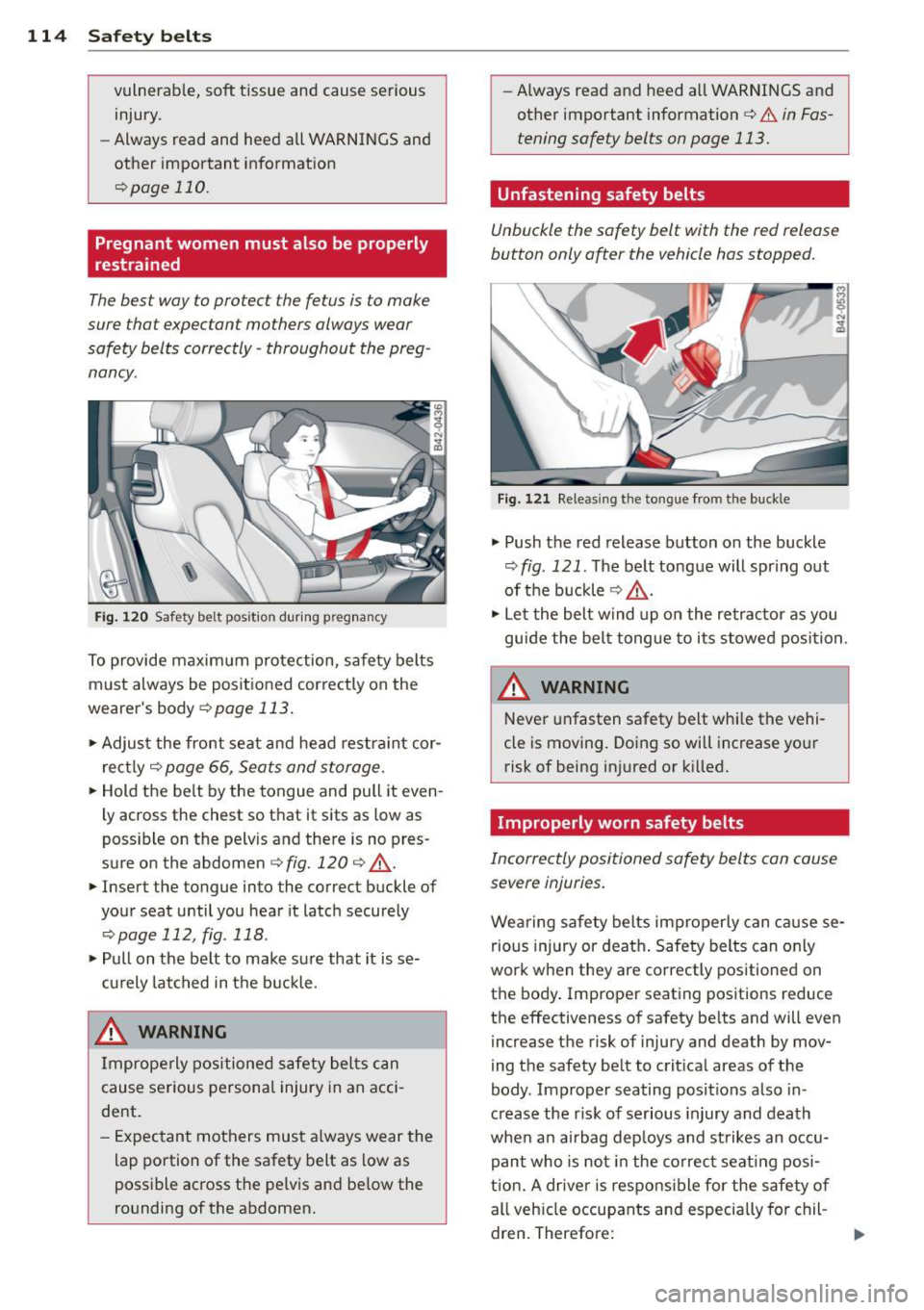
114 Safety belts
vulnerable, soft tissue and cause serious injury.
- Always read and heed all WARNINGS and
other important information
¢page 110.
Pregnant women must also be properly
restrained
The best way to protect the fetus is to make
sure that expectant mothers always wear
safety belts correctly -throughout the preg
nancy .
Fig. 120 Safety belt position during p regnancy
To provide maximum protection, safety belts
must always be positioned correctly on the
wearer's body
¢ page 113.
.,. Adjust the front seat and head restraint cor
rectly¢
page 66, Seats and storage .
.,. Hold the belt by the tongue and pull it even
ly across the chest so that it sits as low as
possible on the pelvis and there is no pres
sure on the abdomen
c> fig. 120 c> ,& .
.,. Insert the tongue into the correct buckle of
your seat until you hear it latch securely
¢page 112, fig. 118.
.,. Pull on the belt to make sure that it is se
curely latched in the buckle.
_& WARNING
Improperly positioned safety belts can
cause serious personal injury in an acci
dent.
- Expectant mothers must always wear the
lap portion of the safety belt as low as
possible across the pelvis and below the
rounding of the abdomen. -
Always read and heed all WARNINGS and
other important information
c> & in Fas
tening safety belts on page 113.
Unfastening safety belts
Unbuckle the safety belt with the red release
button only a~er the vehicle has stopped.
Fig. 121 Releasing the tongue from the buck le
.,. Push the red release button on the buckle
c> fig . 121 . The belt tongue will spring out
of the buckle
c> ,& .
.,. Let the belt wind up on the retractor as you
guide the belt tongue to its stowed position .
_& WARNING
Never unfasten safety belt while the vehi
cle is moving. Doing so will increase your
risk of being injured or killed.
Improperly worn safety belts
Incorrectly positioned safety belts can cause
severe injuries .
Wearing safety belts improperly can cause se rious injury or death. Safety belts can only
work when they are correctly positioned on
the body. Improper seating positions reduce
the effectiveness of safety belts and will even
increase the risk of injury and death by mov
ing the safety belt to critical areas of the
body . Improper seating positions also in
crease the risk of serious injury and death
when an airbag deploys and strikes an occu pant who is not in the correct seating posi
tion. A driver is responsible for the safety of all vehicle occupants and especially for chil
dren. Therefore:
Page 117 of 244
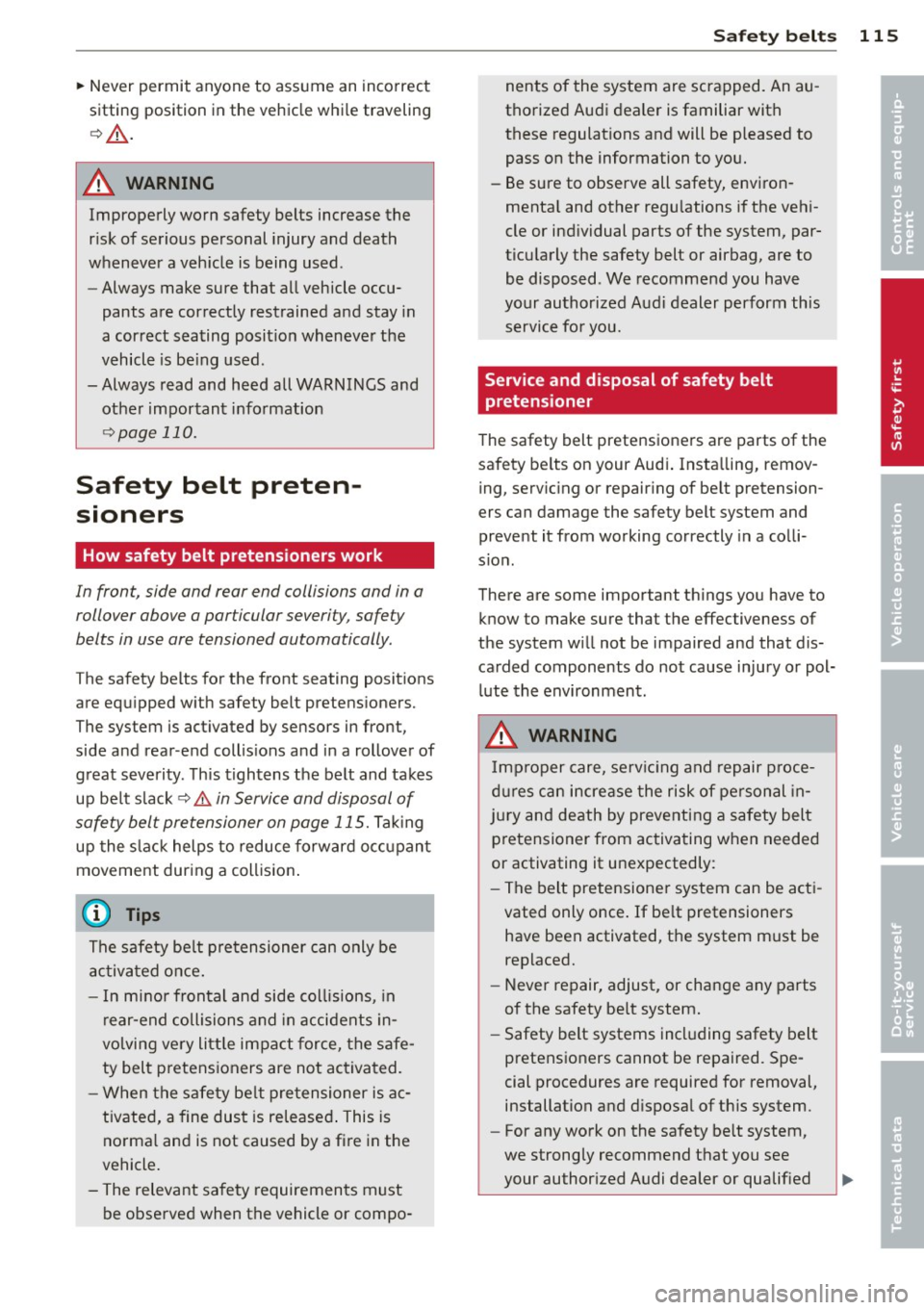
~ Never permit anyone to assume an incorrect
sitting position in the vehicle while traveling
¢A .
A WARNING
Improperly worn safety belts increase the
risk of serious personal injury and death
whenever a vehicle is being used .
- Always make sure that all vehicle occu
pants are correctly restrained and stay in
a correct seating position whenever the
vehicle is being used .
- Always read and heed all WARNINGS and other important information
¢page 110.
Safety belt preten
sioners
How safety belt pretensioners work
In front, side and rear end collisions and in a
rollover above a particular severity, safety
belts in use are tensioned automatically.
The safety belts for the front seating positions
are equipped with safety belt pretensioners.
The system is activated by sensors in front,
side and rear-end collisions and in a rollover of
great severity . This tightens the belt and takes
up be lt slack ¢&.
in Service and disposal of
safety belt pretensioner on page 115.
Taking
up the slack helps to reduce forward occupant
movement during a collision .
(D Tips
The safety belt pretensioner can only be
activated once.
- In minor frontal and side collisions in
,
rear-end collisions and in accidents in
volving very little impact force, the safe
ty belt pretensioners are not activated.
- When the safety be lt pretensioner is ac
tivated, a fine dust is released . This is
normal and is not caused by a fire in the
vehicle.
- The relevant safety requirements must
be observed when the vehicle or compo-
Safety belts 115
nents of the system are scrapped. An au
thorized Audi dealer is familiar with
these regulations and will be pleased to
pass on the information to you.
- Be sure to observe all safety, environ
mental and other regulations if the vehi
cle or individual parts of the system, par
ticularly the safety belt or airbag, are to
be disposed . We recommend you have
your authorized Audi dealer perform this
service for you.
Service and disposal of safety belt
pretensioner
The safety belt pretensioners are parts of the
safety belts on your Audi. Installing, remov
ing, servicing or repairing of be lt pretension
ers can damage the safe ty belt system and
prevent it from working correctly in a colli
sion .
There are some important things you have to know to make sure that the effectiveness of
the system will not be impaired and that dis
carded components do not cause injury or pol
lute the environment.
A WARNING
Improper care, servicing and repair proce
dures can increase the risk of personal in
jury and death by preventing a safety belt
pretensioner from activating when needed
or activating it unexpectedly :
- The belt pretensioner system can be acti
vated only once. If belt pretensioners
have been activated, the system must be
replaced.
- Never repair, adjust, or change any parts
of the safety belt system.
- Safety belt systems including safety belt
pretensioners cannot be repaired. Spe
cial procedures are required for removal,
installation and disposal of this system.
- For any work on the safety be lt system,
we strongly recommend that you see
your authorized Audi dealer or qualified
~
•
•
Page 118 of 244
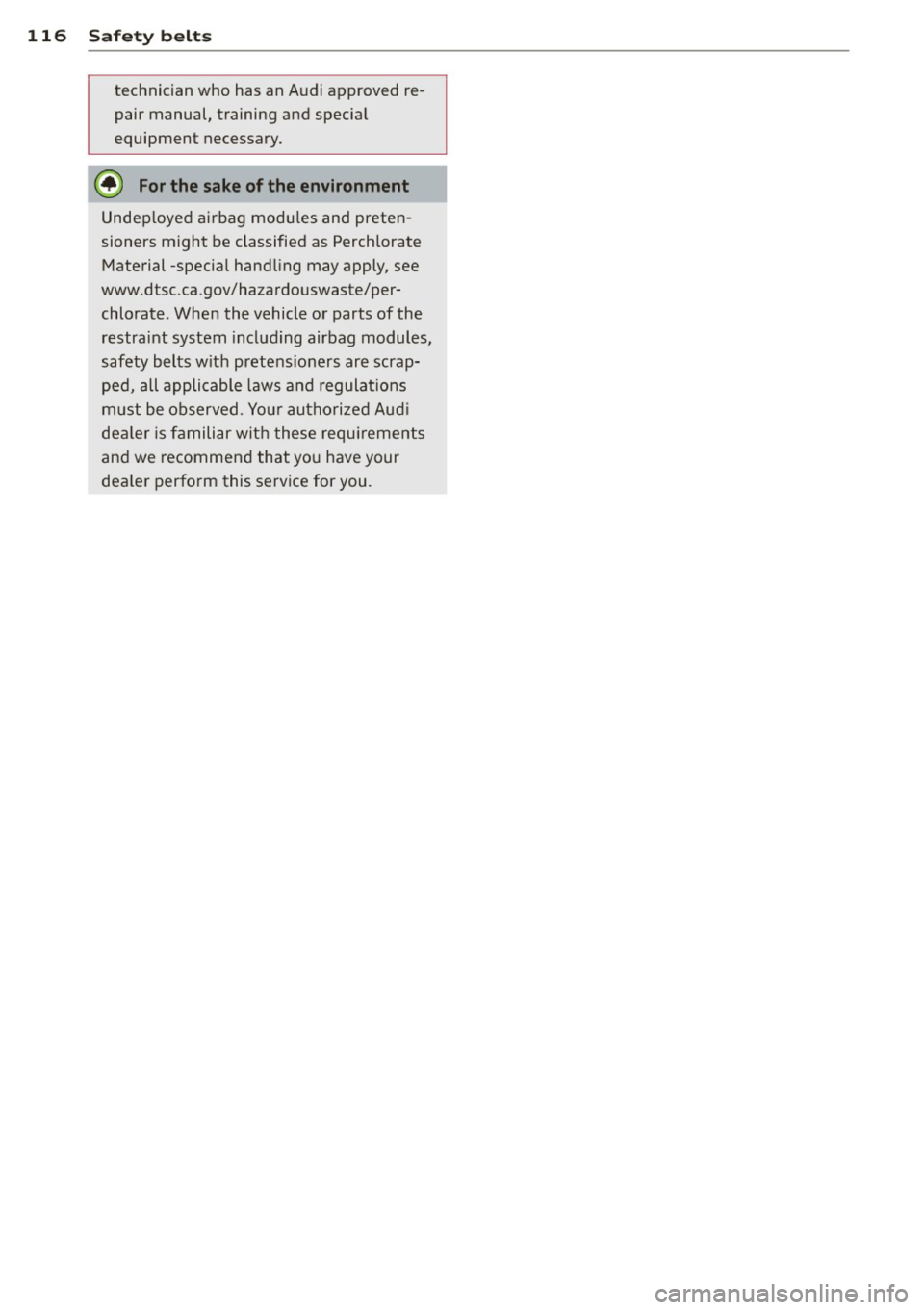
116 Safety belt s
technician who has an A udi approved re
pair manual, training and special
equipment necessary.
@ For the sake of the environment
Undep loyed airbag modu les and preten
sioners might be classified as Perchlorate
Material -specia l hand ling may apply, see
www.dtsc.ca.gov/haza rdouswaste/per
chlorate. When the vehicle or parts of the
restraint system including airbag modules,
safety belts w ith pretens ioners are scrap
ped, all applicable laws and regulat ions
m ust be observed. Yo ur autho rize d Aud i
dea le r i s familiar with these requ iremen ts
and we recommend that you have your
dea ler perfo rm this service for you.
Page 119 of 244
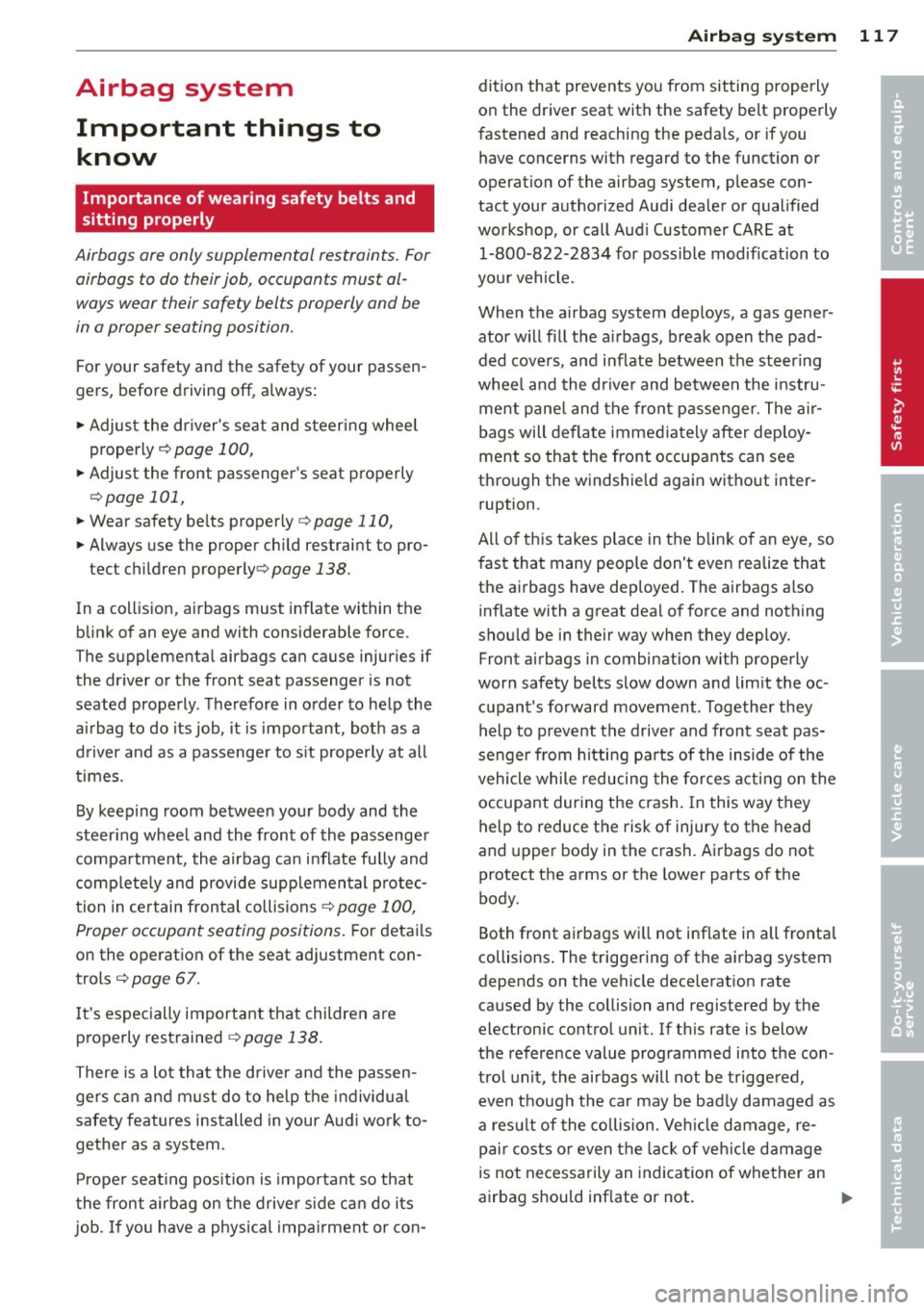
Airbag system Important things to know
Importance of wearing safety belts and
sitting properly
Airbags are only supplemental restraints. For
airbags to do their job , occupants must al
ways wear their safety belts properly and be
in a proper seating position.
For your safety and the safety of your passen
gers, before driving off, always:
"" Adjust the driver's seat and steering wheel
properly ¢
page 100,
"" Adjust the front passenger's seat properly
¢ page 101,
""Wear safety be lts properly r::::> page 110,
""Always use the proper child restraint to pro-
tect children properly¢
page 138.
In a collision, airbags must inflate within the
blink of an eye and with considerable force .
The supplemental airbags can cause injuries if
the driver or the front seat passenger is not
seated properly . T herefore in order to help the
airbag to do its job, it is important, both as a
d river and as a passenge r to s it properly at all
times.
By keeping room between your body and the
steer ing whee l and the front of the passenger
compartment, the airbag can inflate fully and
comp letely and provide supp lemental protec
tion in certain frontal collisions
r::::> page 100,
Proper occupant seating positions.
F or detai ls
on the operation of the seat adjustment con
trols
r::::> page 67.
It's especially important that children a re
properly restrained
r::::> page 138.
There is a lot that the driver and the passen
ge rs can and must do to help the individua l
safety features installed in your Aud i work to
gether as a system.
P roper seat ing pos ition is important so that
the front airbag on the driver s ide ca n do its
job. If yo u have a physical impa irment or con-
A irbag system 117
dition that prevents yo u from sitting properly
on the driver seat with the safety belt properly
fastened and reach ing the peda ls, or if you
have concerns with regard to the function or
operation of the airbag system, please con
tact your authorized Audi dealer or qualified
workshop , or call Audi Customer CARE at
1-800-822-2834 for possible modification to
you r vehicle.
When the airbag system dep loys, a gas gener
ator will fill the a irbags, break open the pad
ded covers, and inflate between the steer ing
whee l and the dr ive r and between the instru
ment pane l and the front passenger. The a ir
bags will deflate immediately after deploy
ment so that the front occupants can see
through the windshield again without inter ruption .
A ll of th is takes place in the blink of an eye, so
fast that many people don't even realize that
the airbags have deployed. The airbags a lso
inflate with a great dea l of force and nothing
should be in their way when they deploy.
Front airbags in combination with properly
worn safety belts slow down and lim it the oc
cupant's fo rward movement . T ogethe r they
help to prevent the driver and front seat pas
senger from hitting pa rts of the inside of the
vehicle while reducing the forces acting on the
occupant during the crash . In this way they
help to reduce the risk of injury to the head
and upper body in the crash. Airbags do not
protect the arms or the lower parts of the
body.
Both front airbags wi ll not inf late in all fronta l
collisions . The t riggering of the airbag system
depends on the vehicle dece lerat ion rate
caused by the collision and registered by the
electronic control unit. If th is rate is below
the reference value programmed into the con
trol unit, the airbags will not be triggered, even though the car may be bad ly damaged as
a res ult of the co llision . Ve hicl e damage, re
pair costs or even the lack of veh icle damage
is not necessarily an indication of whether an
airbag should inf late or not . .,. •
•
Page 120 of 244
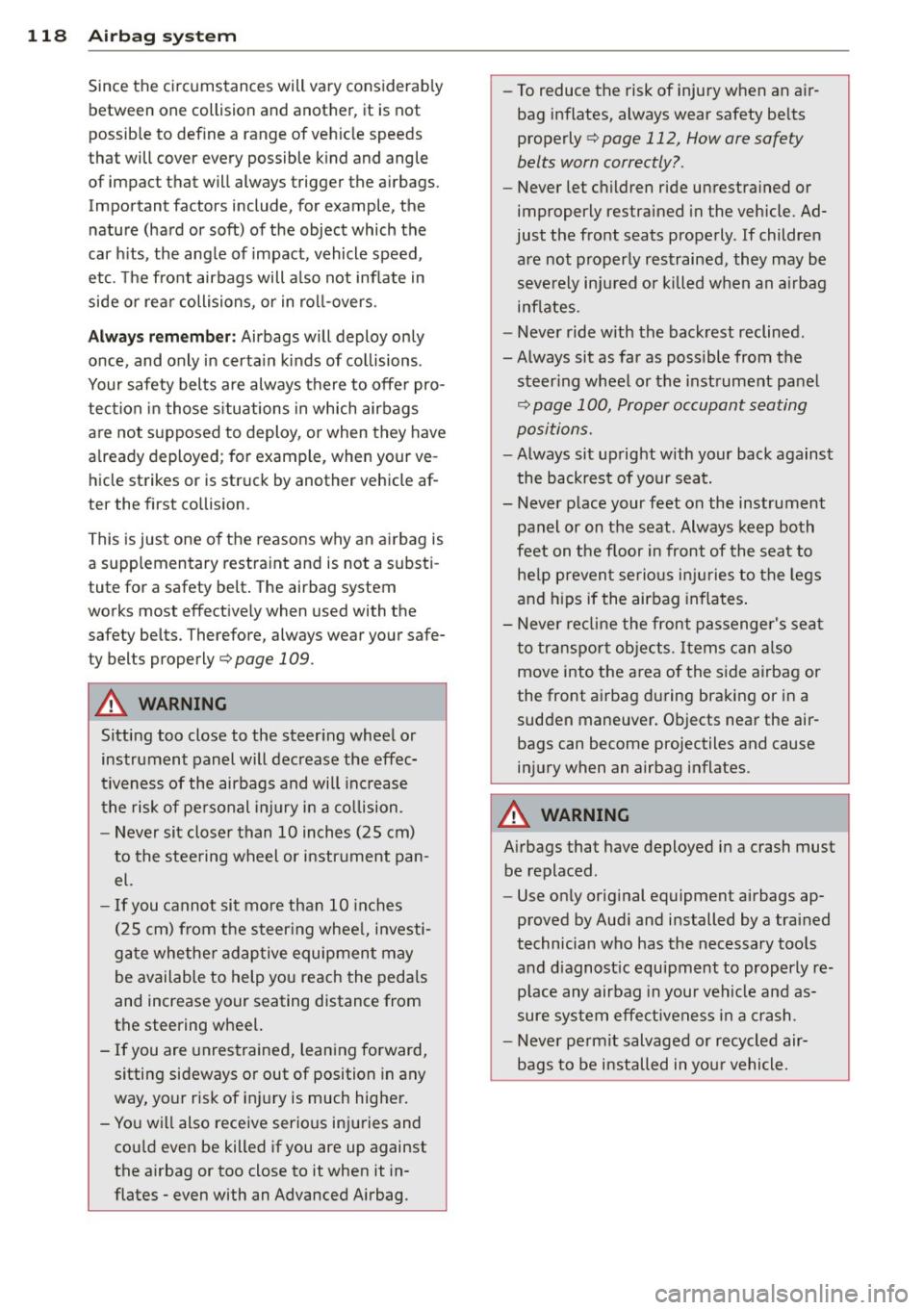
118 Airbag sys te m
Since the cir cumstances will vary considerab ly
between one collision and anot her, it is not
possib le to def ine a range of vehicle speeds
that will cover every possible k ind and angle
of impact that will always trigger the airbags.
Important factors include, for example, the
nature (hard or soft) of the object which the
car h its, the ang le of impact, vehicle speed,
etc. The front airbags will also not inflate in
side or rea r collisions, or in ro ll-overs .
Always remember : Airbags will deploy only
once, and only in certa in kinds of co llisions.
Your safety belts are always there to offer pro
tection in those s ituations in which airbags
are not supposed to deploy, or when they have
a lready deployed; for example, when your ve
hicle strikes or is struck by another vehic le af
ter the first co llision.
This is just one of the reasons why an airbag is
a supplementary restraint and is not a substi
tute for a safety belt . The airbag system
works most effect ively when used with the
safety belts. Therefore, always wear your safe
ty belts properly
c;, page 109.
A WARNING
Sitting too close to the steer ing wheel or
instrument panel will dec rease the effec
tiveness of the airbags and will increase
t he risk of personal injury in a co llision .
- Never sit closer than 10 inches (2S cm)
to the stee ring wheel or instrument pan
el.
- If you cannot sit more than 10 inches
( 2 5 cm) from the steer ing whee l, investi
ga te whethe r adaptive equipmen t may
be available to help you reach the pedals
and increase your seating distance from
the steering wheel.
- If you are unrestrained, lean ing fo rward,
sitting sideways or out of position in any
way, your risk of in jury is much higher.
- You will also receive serio us inj uries and
cou ld even be killed if you are up against
the airbag or too close to it when it in
flates - even with an Advanced Airbag. -
To reduce the risk of injury when an a ir
bag inflates, always wear safety be lts
properly ¢
page 112, How are safety
belts worn correctly? .
-Never let children ride unrestrained or
improperly restrained in the vehicle. Ad
just the front seats properly . If children
are not p roperly restrained, they may be
seve rely in ju red or killed when an a irbag
infla tes.
- Never ride with the back rest reclined.
-Always sit as far as possible from the steer ing whee l or the instrument pane l
c;, page 100, Prop er occupant seating
positions.
- Always sit up right with your back against
the backres t of your seat.
- Never p lace your feet on the instrument
panel or on the seat. Always keep both
feet on the f loor in front of the sea t to
he lp preven t serio us in juries to the legs
and h ips if the airbag infla tes .
- Never re cline the front passenger's sea t
to tr anspor t ob jec ts. Items c an al so
move into the a rea of the s ide airbag or
the front airbag during braking or in a
sudden maneuver . Objects near the air
bags can become projectiles and cause
in ju ry when an airbag inflates.
A WARNING
Airbags that have deployed in a crash must
be replaced.
- Use on ly orig inal equipment airbags ap
proved by Aud i and installed by a trained
technician who has the necessary tools and d iagnost ic equipment to properly re
p lace any airbag in your vehicle and as
sure sy stem effe ctive ness in a crash.
- Never permit salvaged or recycled air
bags to be installed in you r vehicle.